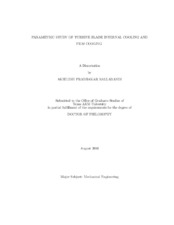Parametric Study of Turbine Blade Internal Cooling and Film Cooling
Abstract
Gas turbine engines are extensively used in the aviation and power generation
industries. They are used as topping cycles in combined cycle power plants, or as
stand alone power generation units.
Gains in thermodynamic efficiency can be realized by increasing the turbine
inlet temperatures. Since modern turbine inlet temperatures exceed the melting
point of the constituent superalloys, it is necessary to provide an aggressive cooling
system. Relatively cool air, ducted from the compressor of the engine is used to
remove heat from the hot turbine blade. This air flows through passages in the
hollow blade (internal cooling), and is also ejected onto the surface of the blade to
form an insulating film (film cooling).
Modern land-based gas turbine engines use high Reynolds number internal flow
to cool their internal passages. The first part of this study focuses on experiments
pertaining to passages with Reynolds numbers of up to 400,000. Common turbulator
designs (45degree parallel sharp-edged and round-edged) ribs are studied. Older
correlations are found to require corrections in order to be valid in the high Reynolds
number parameter space.
The effect of rotation on heat transfer in a typical three-pass serpentine channel
is studied using a computational model with near-wall refinement. Results from this
computational study indicate that the hub experiences abnormally high heat transfer under rotation. An experimental study is conducted at Buoyancy numbers similar to
an actual engine on a wedge shaped model trailing edge, roughened with pin-fins and
equipped with slot ejection. Results show an asymmetery between the leading and
trailing surfaces due to rotation - a difference which is subdued due to the provision
of pin-fins.
Film cooling effectiveness is measured by the PSP mass transfer analogy technique
in two different configurations: a flat plate and a typical high pressure turbine
blade. Parameters studied include a step immediately upstream of a row of holes; the
Strouhal number (quantifying rotor-stator interaction) and coolant to mainstream
density ratio. Results show a deterioration in film cooling effectiveness with on increasing
the Strouhal number. Using a coolant with a higher density results in higher
film cooling effectiveness.
Citation
Rallabandi, Akhilesh P. (2010). Parametric Study of Turbine Blade Internal Cooling and Film Cooling. Doctoral dissertation, Texas A&M University. Available electronically from https : / /hdl .handle .net /1969 .1 /ETD -TAMU -2010 -08 -8427.


